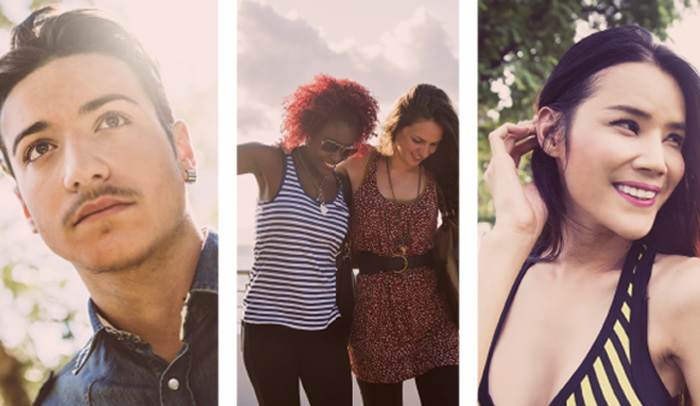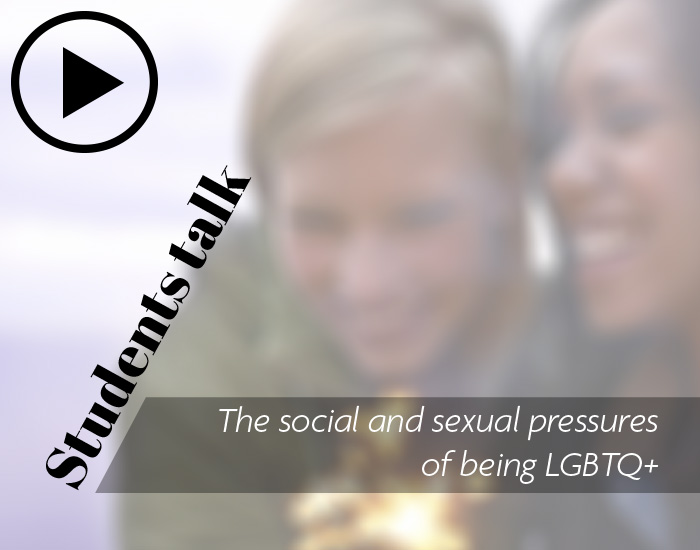Preventing sexual assault in LGBTQ student communities

 Gabe Murchison is senior research manager at Human Rights Campaign, the largest LGBTQ advocacy organization in the US. Murchison’s postgraduate research at Yale University examined sexual assault risk factors facing LGBTQ people.
Gabe Murchison is senior research manager at Human Rights Campaign, the largest LGBTQ advocacy organization in the US. Murchison’s postgraduate research at Yale University examined sexual assault risk factors facing LGBTQ people.
 Dr. Corey Flanders is a postdoctoral research fellow at the Centre for Addiction and Mental Health, in Toronto, Ontario. She conducts research with sexual-minority and gender-minority people, predominantly on mental, sexual, and reproductive health inequities.
Dr. Corey Flanders is a postdoctoral research fellow at the Centre for Addiction and Mental Health, in Toronto, Ontario. She conducts research with sexual-minority and gender-minority people, predominantly on mental, sexual, and reproductive health inequities.

Why did you do this research?
Murchison: “To prevent sexual violence we have to understand how it happens, and there’s very little research on violence against LGBTQ students. Overall, our data suggests that LGBTQ students’ unwanted sexual experiences are similar to what we know about heterosexual, cisgender women’s; in our study, many of the perpetrators were friends or romantic partners. However, students with more internalized homophobia were more likely to have experienced sexual assault and coercion, while students with a stronger sense of LGBTQ community were less likely to have had those experiences.”
Flanders: “I wanted to know whether bisexual women are more likely to be sexually assaulted, compared to heterosexual women, and if they are, whether that’s because of certain assumptions people make about them. I also wanted to understand how young bisexual women perceive their sexual and reproductive health needs, the challenges to achieving those needs, and the factors contributing both positively and negatively to their sexual and reproductive health.”
How different is trans students’ experience?
Murchison: “In my sample and another recent US study, transgender students experienced the highest rates of sexual assault and coercion. Trans students report facing more discrimination than non-trans LGBQ peers. Some students are even targeted for sexual assault because they are trans.”
Flanders: “In our study, participants said that because they identified as trans, their health providers didn’t believe them when they talked about their sexual health experiences and needs. So that creates another barrier to accessing services, if experiencing sexual assault or being believed to have been a survivor of sexual assault.”
 Definitions: transgender, gender non-conforming, cisgender, & more
Definitions: transgender, gender non-conforming, cisgender, & more
This list is adapted from the Glossary of Terms published by the Human Rights Campaign. Terminology relating to gender and sexual identity is variable (e.g., a non-cisgender person may identify as transgender, gender non-conforming, non-binary, queer, or genderqueer). Always respect individuals’ preferences.
Asexual The person does not experience sexual attraction or desire for other people.
Bisexual The person is emotionally, romantically, or sexually attracted to more than one sex, gender, or gender identity.
Cisgender A person’s gender identity aligns with the sex assigned to them at birth.
Gay The person is emotionally, romantically, or sexually attracted to people of the same gender.
Gender identity A person’s innermost concept of self as male, female, a blend of both, or neither; how individuals perceive themselves, and what they call themselves.
Gender non-conforming The person does not behave in a way that conforms to the traditional expectations of their gender, or their gender expression does not fit neatly into a category; also termed “non-binary.”
Genderqueer The person rejects static categories of gender and embraces a fluidity of gender identity (and often, though not always, sexual orientation); may see themselves as being both male and female, neither male nor female, or outside these categories.
Homophobia The fear and hatred of, or discomfort with, people who are attracted to those of the same sex.
Lesbian The woman is emotionally, romantically, or sexually attracted to other women.
LGBT An acronym for “lesbian, gay, bisexual, and transgender.”
Queer Fluid gender identity and/or sexual orientation; often used interchangeably with “LGBT.”
Transgender The person’s gender identity and/or expression is different from cultural expectations based on the sex they were assigned at birth; transgender people may identify as straight, gay, lesbian, bisexual, etc.
Transphobia The fear and hatred of, or discomfort with, transgender people.
What’s the difference between transgender and gender non-conforming?
Gabe Murchison:
“I use transgender to refer to people who identify with a different gender than they were assigned at birth. I use gender non-conforming to refer to people who consistently and noticeably express themselves outside of the norms for their gender.
“Like anyone else, a transgender person could be gender-conforming or non-conforming after they transition. Some transgender men dress and act in stereotypically masculine ways, while others are more feminine than the average man, and the same is true of transgender women.
“There are also many transgender people who don’t identify exclusively as men or women, but as neither, or a combination of both. I use the umbrella term ‘non-binary’ for these identities, because they are outside of the male-female ‘gender binary.’
“Many health researchers use the umbrella term ‘gender minorities’ to describe transgender and gender non-conforming people. In the study we’re discussing, I didn’t ask participants about being gender non-conforming, so I can only talk about transgender students’ experiences. Other research has found that LGBTQ youth who are gender non-conforming have different experiences than those who are gender-conforming—for instance, they are more likely to be bullied in school. Whether being gender non-conforming affects the likelihood of experiencing sexual violence is an important question for future research.”
 What are internalized homophobia and transphobia?
What are internalized homophobia and transphobia?
What is internalized homphobia?
Gabe Murchison:
“Living in a culture that stigmatizes one or more of your identities—your race, status, sexual orientation, or many others—can affect your health negatively. One way is through internalized stigma: when you come to consciously or unconsciously believe the negative cultural ideas about yourself. Internalized homophobia is internalized stigma about being lesbian, gay, bisexual, or queer.
“Absorbing negative beliefs about one’s LGBTQ identity can cause a range of problems, like making someone more prone to depression or anxiety, or affecting their sexuality and relationships.
“For instance, it appears that some abusers take advantage of internalized homophobia to control their partners. When we were planning our research, we thought that sexual aggressors could do something similar, and there was some qualitative research (interviews with LGBTQ people about their unwanted sexual experiences) backing that up.
“It’s important to note that internalized stigma is not something to be ashamed of. It’s an almost unavoidable consequence of having any stigmatized identity, but most people find positive ways to cope with it.”
What is internalized transphobia?
Internalized transphobia may occur at a higher rate than internalized homophobia, research suggests. In a 2016 study, transgender participants reported higher rates of discrimination, depression symptoms, and suicide attempts than cisgender LGB participants. Among transgender people, depression symptoms were associated with a lack of self-acceptance around identity, researchers wrote (Transgender Health).
Transgender, gender non-conforming, and genderqueer people experience pressure from multiple sources. “According to research, stressors include being bullied at school and work, reduced access to housing, loss of friends and family, physical violence, harassment, and assault, and reduced medical access,” says Joleen Nevers, sexuality educator at the University of Connecticut.
Dr. Corey Flanders:
“With all of the negative stereotypes about transgender people, even if you recognize these are not based in truth or not based in your experience, it can still be really difficult to not take on those negative messages. Sometimes you apply those messages to yourself even if they aren’t an accurate reflection of your experience or your identity.
“For example, the message that trans people are confused about gender identity; this is a stereotype that isn’t necessarily true. But if you have internalized that, then you might feel like you should be confused about your identity, or that the stressors you’ve experienced related to your identity are somehow a reflection of your confusion.”
 What did researchers look at?
What did researchers look at?
Gabe Murchsion: “We surveyed about 700 LGBQ college students at hundreds of colleges and universities. We used this data to look at three big questions: First, is sexual violence against LGBTQ undergraduates basically similar to what heterosexual, cisgender women tend to experience? Or do ‘hate crime’ attacks play a big role? Second, do LGBTQ students have unique experiences that affect their risk of sexual violence? Third, we knew very little about gender: Do LBQ women tend to be assaulted by men, women, or both? What about GBQ men? And what about people with a non-binary gender? That would help us understand whether this violence tends to take place within LGBTQ relationships or communities, or whether it’s mostly perpetrated by heterosexuals.”
Dr. Corey Flanders: “The majority of my research on sexual violence has focused on young bisexual women or women who use other identities to describe attraction to more than one gender, such as pansexual women. For example, we conducted a community-based research project that included an advisory committee of young bisexual women, academic partners, and a community health centre. Four 2-hour focus group sessions were conducted with 35 participants. Participants found that negative stereotypes around bisexuality made it really difficult for them to navigate conversations around sexual consent. Oftentimes, potential sexual partners would see them as automatically consenting because of their identity. Sometimes the stereotypes were used as justification for people who had committed sexual assault against young bisexual women.”
How do negative cultural norms affect sexual assault in LGBTQ communities?
Murchison: “Some students who wanted to make friends with other LGBTQ people felt like the only way to do that was to be part of a hookup scene. That led to them having consensual sex they didn’t really want, and sometimes made them targets for coercion. Also, some people talked about experiencing sexual aggression when they were newly out, and thinking maybe that was normal or acceptable among LGBTQ people—because they didn’t yet have many LGBTQ friends to discuss it with.”
Flanders: “In our study, participants spoke to the stereotype that bisexual people are seen as being hypersexual, and felt this may be associated with justifications for committing sexual assault against bi-people: ‘You must want it all the time from everyone, so I’m going to treat you that way.’ Another participant identified as pansexual, and she had trouble navigating consent with female-identified partners who did not understand why she did not want penetration: ‘Well, you have sex with cis men.’”
 How can schools help?
How can schools help?
Gabe Murchison: “All programming should include LGBTQ students among its examples. Health, sexuality, and sexual violence workshops should feature characters with gender-neutral names and point out that both consensual sex and sexual violence can occur in any gender combination.”
Dr. Corey Flanders: “Visibility campaigns can do a lot—a poster campaign that points out what sexual stigma looks like for the LGBTQ community, or a video campaign, either in school buildings or through social media, to get people looking at messages they hear and thinking critically about them. For example, the study participants really wanted consent-based education with a specific lens on sexual stereotypes around sexual minority people—e.g., that hypersexuality among bi people is a myth.”
 What if there isn’t a strong LGBTQ community?
What if there isn’t a strong LGBTQ community?
Seek out online communities
Dr. Corey Flanders: “Online support resources may be helpful. You can seek out bubbles of community on places like Reddit or Facebook or other other peer-to-peer online groups. Some help lines offer phone, online chat, or text-based support.” See Find out more today (on the page).
Socialize broadly
Gabe Murchison: “It’s important to have friends who support your sexual orientation or the fact that you’re transgender—but that doesn’t mean they have to be LGBTQ. Many LGBTQ students make their closest friends through athletics, arts, religious organizations, or housing assignments. For some, most or all of those friends are straight and cisgender. Since LGBTQ people are just as diverse as any other group, it’s very likely that you’ll meet like-minded LGBTQ friends throughout your life, even if you don’t fit in with the LGBTQ students you’ve met.”
How can we build a safer culture?
Create non-sexual spaces and conversations
Murchison: “In the peer educator program at Yale, we decided that building a stronger sense of community could help. First, we got LGBTQ student leaders on board to help change the way people in their circles talked about hooking up, and also to be intentionally welcoming to younger students. Second, we started hosting LGBTQ events that were not at all sexualized—like a fantastic pie-baking event that’s become an annual tradition.”
Build discussion into the curriculum
Flanders: “We need to be talking about sexual assault in a broader context and identifying how cultural bias permeates so many levels of our society and our universities. This doesn’t need to be limited to educational conversations around sexual health. If you have an English class or a film class and one of the texts that you’re using is perpetuating negative stereotypes and assumptions about sexuality and gender, call that out and talk about it.”
How can all students support LGBTQ peers?
Check in with friends and younger students
Murchison: “Checking in is really valuable. If someone is in an intense relationship and you’re not sure if it’s good-intense or bad-intense, you can ask some open-ended questions—like, ‘How are things with Ryan?’ Even if everything is fine, they’ll feel supported. Reaching out to younger or newly out students can be especially effective. They may be particularly vulnerable to sexual assault, or just plain loneliness.”
Educate yourself and avoid making assumptions
Flanders: “First recognize that people who identify as LGBTQ do experience sexual assault and sexual violence. The rates of sexual violence among young queer, or sexual minority, women are typically reported higher than that among heterosexual women.”
How common is sexual assault?
Gabe Murchison: “There are not a ton of data on LGBTQ undergraduates specifically. From what exists, it appears that:
- “Gay, bi, and queer men are at higher risk than other men (but still at lower risk than women).
- “Lesbian, bi, and queer women seem to be at similar or slightly higher risk compared to other women.
- “Transgender students, particularly those with non-binary gender identities (not exclusively male or female), seem to be at higher risk than cisgender students.”
“‘Queer’ is how respondents self-identified. Thirteen percent of my sample described their sexual orientation as queer. The term has been adopted by the major US advocacy organizations and is used in some (not all) research on this population.”
More ways for students to be allies to LGBTQ peers
Pay attention to who seems left out
Gabe Murchison: “Some students don’t participate in the LGBTQ community because they have other friends or feel excluded—the most visible LGBTQ social groups might be mostly white, mostly a particular gender, mostly secular. Also, not all LGBTQ communities are great at supporting transgender, non-binary, or bisexual students. Set an example by learning more about being bi- and trans-inclusive, and asking your friends to do the same. Also, do your best not to assume someone is heterosexual or cisgender.”
Speak up for inclusion
Dr. Corey Flanders: “If you hear someone saying something transphobic or biphopic or homophobic, call people out on that. Take some of that weight—for example, when people make rape jokes, if you’re safe to do so, you can point out how sexual violence is not a laughing matter. If it’s not safe, you can think about starting conversations with others about the importance of taking sexual violence seriously.”






